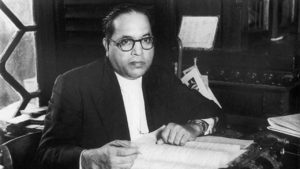
October 14, 1956 was clearly an important moment in Dalit history. On this day, B R Ambedkar along with 365,000 of his Dalit followers decided to exit the folds of Hinduism and embraced Buddhism. Ambedkar’s conversion to Buddhism marked a moment when Dalits in the country got a new impetus and a voice that was hitherto constrained by the four-fold varna system dominating Hinduism. Ambedkar had long been frustrated by the basic tenets of Hinduism, and considered the inherent characteristics of the religion, particularly the caste system to be a bigger threat to freedom in Indian society than that of the British. Unlike Mahatma Gandhi, who considered the internal reform of the caste system to be the way forward, Ambedkar believed that the only way the Dalits could find a place for themselves in Indian society was by way of conversion.
In May, 1936 Ambedkar addressed a huge gathering of Mahars in Mumbai, where he declared his ideas on conversion, and why he considered it to be the best route towards emancipation. “I tell you all very specifically, religion is for man and not man for religion. To get human treatment, convert yourselves,” said Ambedkar. However his switch to Buddhism was hardly impromptu. He spent the next 20 years contemplating on which religion would suit his requirements best. He dismissed the idea of converting to Islam or Christianity, because of the foreignness attached to them. As explained by professor Gauri Vishwanathan, Ambedkar clearly did not want to betray the folds of ‘Indianness’ even when he decided to convert to a different religion. However, he chose Buddhism after a long drawn out process of contemplation on the religion, and in fact came out with his own version of the Buddhist Dhamma, where he modified those aspects of Buddhism which he considered as not aligning with the overall rationality, inherent of the religion.
Unfortunately, Ambedkar did not live long thereafter to practice Buddhism and passed away just two months after his official conversion. Since his death, scholars have for decades tried to reflect upon Ambedkar’s reasons for conversion, and his choice of Buddhism in particular. Here are three major reasons that scholars have contemplated as being the cause behind Ambedkar’s shift to Buddhism.
A common scholarly critique of Ambedkar’s conversion was the fact that it was a political stunt. Ambedkar had for long demanded separate electorates for the untouchables, as a measure of protection against rule of the Hindu majority. After much agitation however, he yielded to give up on his demands in the Poona Pact of 1932, which was signed by Ambedkar along with Pandit Madan Mohan Malviya to break Gandhi’s protest against the separate electorate demand. Several critics like sociologist Gail Omvedt have been of the opinion that Ambedkar’s conversion to Buddhism was a political protest, aimed at his frustration at being unable to get separate electorates for the untouchables.
Life long battle against Hinduism
Ambedkar’s first experience of caste-based segregation happened when he was in school. Since then he grew up battling the oppressions of the caste system at every stage of his life, despite acquiring educational qualifications from across the globe. Several historians have been of the understanding that Ambedkar’s conversion to Buddhism needs to be seen as a product of his life experience and the cultural influences on him.
As per Ambedkar, Hinduism had failed to secure basic human rights. “The Hindu society does not give equality of treatment, but the same is easily achieved by conversion,” said Ambedkar in his speech in Mumbai.
Further, during his growing up years, there were a number of cultural icons that went on to influence his decision. For instance, as discussed by Gauri Vishwanathan, the 12th century Dalit martyre of South India, Nandanar had a strong influence on him. He had inaugurated a tradition of protest from below regarding right to worship for the untouchables. One other historical figure who had an impact on Ambedkar was king Ashoka, whose conversion to Buddhism after the battle of Kalinga is known to have initiated an era of tolerance and service for humanity.
Buddhism as a project of modernity
The most popular view among scholars is the fact that Buddhism was seen as the most modern and rational religion by Ambedkar. The strongest proponent of this theory is religion studies specialist, Christopher Queen. By converting to Buddhism, Queen suggested, Ambedkar fulfilled one of the most basic requirements of attaining modernity- the exercise of individual choice based on reason and historical consciousness. As per this theory, Ambedkar, after much contemplation chose Buddhism as the religion that met his complex requirements of reason, morality and justice. “The appeal of Buddha’s dhamma for Ambedkar was, its emphasis on rational choice,” wrote Gauri Vishwanathan.
In fact, Ambedkar’s idea of Buddhism was considered to be more modern than the ancient form of Buddhism. “The Buddhism of Ambedkar’s late writings recasts the central tenets of ancient Buddhism,” wrote Queen in 1996. He went on to dismiss certain parts of Buddhism, particularly the aspect of the ‘four noble truths’ which he believed was a later addition to Buddha’s teachings due to the influences of Hinduism. Some scholars have gone on to argue that Ambedkar’s idea of Buddhism contained within it, the basic values linked to the French revolution, that being liberty, equality and fraternity.
While scholars continued to debate on Ambedkar’s motives regarding his conversion, what was certain was the momentum it gave to both the Dalit movement and Buddhism in India. As recorded by the census during the decades of 1950s and 60s, as a result of the mass conversions of Dalits following that of Ambedkar, the number of Buddhists in India increased from 141,426 in 1951 to 3,206,142 in 1961.

